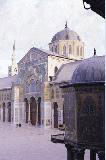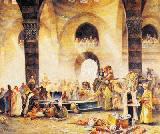The Omayyad Mosque
This Great Mosque stands at the heart of the Old city at the end of Souq al-Hamidiyeh. It was built by the Omayyad Caliph al-Walid ibn Abdul Malek in 705 A.D. when Damascus was the capital of the Arab Islamic Empire.
It was constructed on the site of what has always been a place of worship: first, a temple for Hadad, the Aramean god of the ancient Syrians three thousand years ago; then, a pagan temple (the temple of Jupiter the Damascene) during the Roman era. It was later turned into a church called John the Baptist when Christianity spread in the fourth century. Following the Islamic conquest in 635, Muslims and Christians agreed to partition it between them, and they began to perform their rituals side by side.
When al-Walid decided to erect an impressive mosque suited to the grandeur of the Arab state "whose like was never built before, nor will ever be built after" as he is reported to have said he negotiated with the Christian community of Damascus, and undertook to construct a new church for them (St. John's) and allot several pieces of land for other churches, if they relinquished their right to their part of the Mosque. They agreed. It took ten years and eleven million gold dinars, as well as a huge number of masons, artists, builders, carpenters, marble-layers, and painters to complete. It became an architectural model for hundreds of mosques throughout the Islamic world.
A prominent feature of it are the three minarets built in different styles; the upper parts of which were renovated during the Ayoubite, Mamluk, and Ottoman eras. The mosque has a large prayer hall and an enormous courtyard. The interior walls are covered with mosaic panels, made of coloured and gilded glass, portraying scenes from nature. The dome is greyich-blue, celebrated for its magnificence. The prayer hall contains domed shrine venerated by both Christians and Muslims, the tomb of St. John the Baptist.
The Azem Palace
This also stands at the heart of the Old City, on the southern side of the Omayyad Mosque, and very close to it. It is an astonishing example of a Damascene house, where the simple, almost primitive, exterior contrasts rather sharply with the beauty and sophistication of the interior. Here one finds a sense of space, a wealth of polychrome stone, splendid marble, cascading fountains, and fragrant flowers. The palace was built in the mid-eighteenth century for the Governor of Damascus. The palace now houses the Museum of Arts and Popular Traditions.
Damascus Citadels
The only fortress in Syria built on the same level as the city, it does not top a hill or a mountain like all other castles and citadels. It was erected by the Seljuks in 1078 A.D. with masonry taken from the city wall, and turned into a heavily-fortified citadel surrounded by walls, towers, a moat and trenches. Inside, they built houses, baths, mosques, and schools; it was a city within a city. At the height of Crusader raids and attacks, it was used as residence for the sultans of Egypt and Syria such as Nureddin, Saladin, and al-Malek al-Adel, whence they supervised military operations against the Crusaders. But al-Malek al-Adel soon found that it was no longer adequate for defense against contemporary weapons and siege tactics, so he decided in 1202 to demolish and re-build it. The outcome was an impressive modern citadel, incorporating the latest inventions in the martial arts. It has imposing walls and a dozen colossal turrets surrounding it; there were three-hundred arrow slits and enormous parapets all round. In the mid-thirteenth century, however, it was the principal target for Tatar and Mongol attacks, and was later neglected by the Ottomans. The moats and trenches around it were filled up, and the souqs of Hamidiyeh, Asrounieh, and al-Khuja were built thereon. Recently, the latter was demolished, and the western walls of the fortress came into full view. Extensive repair and restoration work is underway at the moment; when completed the citadel will become a war museum, and a center for various cultural activities.
The Souqs
The old covered souqs of Damascus have a unique flavour you can savor with eyes closed. As you walk about in the warm darkness of these streets with their fragrant scents, spices, and colourful merchandise spilling out of the shops onto the pavements, you enter the strange world of exotic legend. Most prominent of these are:
Souq al-Hamidiyeh
Souq Midhat Pasha
Souq al-Harir
Souq Al-Bzourieh
Bimaristan al- Noury
To the south of Souq al-Hamidiyeh, this was built by Nureddin in the twelfth century as a hospital, and financed by ransom money to the amount of 300,000 dinars paid by a Crusader king held captive. During the Ottoman periood it was converted into a school for girls, and it now houses the Museum of Arab Medicine and Science. It contains the most exquisite examples of decorative inscriptions used for the first time during Nureddin's reign to replace the traditional kufi inscriptions.
Saladin's Tomb and its neighboring Schools
The tomb is next door to the north gate of the Omayyad Mosque. It was originally part of al-Azizieh School built by Uthman, Saladin's son, in the twelfth century. The whole interior is decorated with polychrome marble mosaics.
Next to the tomb stands a typical mamluk edifice, the Jumaqjieh School, built in the twelfth century. The interior is decorated with inscriptions and beautiful lettering. It is one of the most splendid old schools in Damascus; and has recently been turned into a Museum of Arabic Calligraphy.
Two other schools stand nearby: al-Zhahiriya, which is an Ayoubite edifice and house the famous library of that name; and al-Adliya, which is also Ayoubite in style, and is now headquarters of the Arab language Academy.
ST. Paul's Churches
St. Paul's Church / Bab Keissan /
Is situated behind Bab Keissan, one of the gates in the old wall encircling Damscus.
It commemorates the memory of St. Paul, whose name was Saul of Tarsus, charged by the Romans to persecute the Christians. As he approached the village of Daraya, a burst of blinding light took his sight away, and he heard Jesus Christ ask him "Saul, why do you persecute me? This was a vision of faith. He was taken unconscious to Damascus, attended by Hananiya, Christ's disciple, and became one of the staunchest advocates of Christianity. His Jewish peers decided to kill him, but he hid in a house by the city wall. The church is located at the site of his escape. He traveled to Antioch, Athens, and Rome, after a brief stay in Jerusalem, and continued to teach the gospel until he died.












